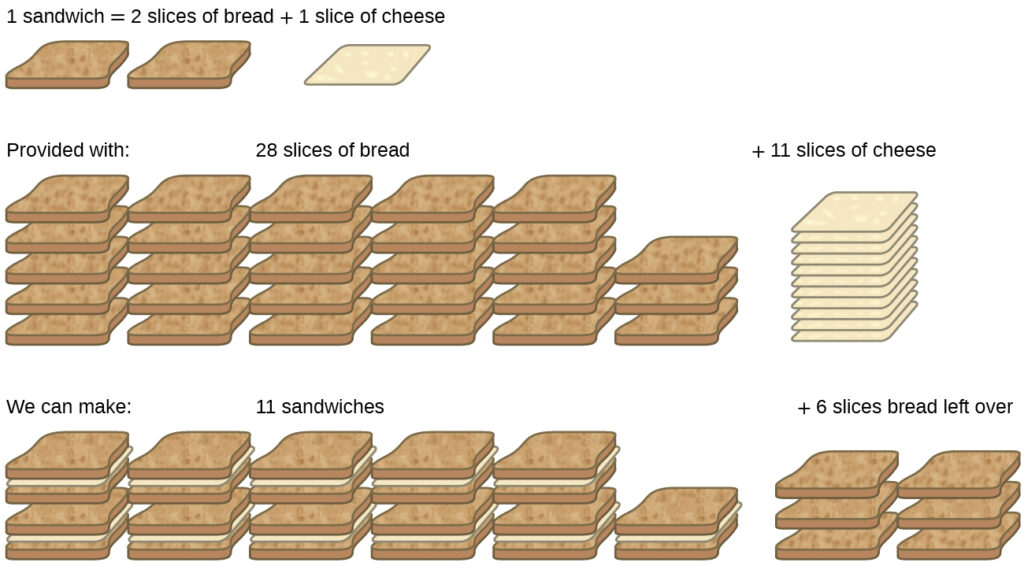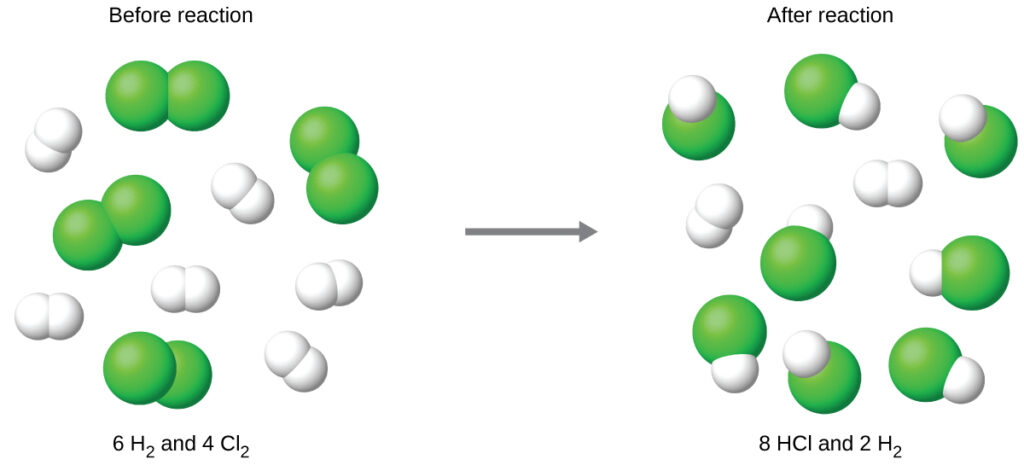The relative amounts of reactants and products represented in a balanced chemical equation are often referred to as stoichiometric amounts. All the exercises of the preceding module involved stoichiometric amounts of reactants. For example, when calculating the amount of product generated from a given amount of reactant, it was assumed that any other reactants required were available in stoichiometric amounts (or greater). In this module, more realistic situations are considered, in which reactants are not present in stoichiometric amounts.
Limiting Reactant
Consider a food analogy, making grilled cheese sandwiches (see figure below)
2 slices of bread + 1 slice of cheese ⟶ 1 sandwich
Stoichiometric amounts of sandwich ingredients for this recipe are bread and cheese slices in a 2:1 ratio. Provided with 28 slices of bread and 11 slices of cheese, one may prepare 11 sandwiches per the provided recipe, using all the provided cheese and having six slices of bread leftover. In this scenario, the number of sandwiches prepared has been limited by the number of cheese slices (the limiting reagent), and the bread slices have been provided in excess (the excess reagent).

Consider this concept now with regard to a chemical process, the reaction of hydrogen with chlorine to yield hydrogen chloride:
H2(g) + Cl2(g) ⟶ 2HCl(g)
The balanced equation shows the hydrogen and chlorine react in a 1:1 stoichiometric ratio. If these reactants are provided in any other amounts, one of the reactants will nearly always be entirely consumed, thus limiting the amount of product that may be generated. This substance is the limiting reagent (also called limiting reactant), and the other substance is the excess reagent (also called the excess reactant). Identifying the limiting and excess reactants for a given situation requires computing the molar amounts of each reactant provided and comparing them to the stoichiometric amounts represented in the balanced chemical equation. For example, imagine combining 3 moles of H2 and 2 moles of Cl2. This represents a 3:2 (or 1.5:1) ratio of hydrogen to chlorine present for reaction, which is greater than the stoichiometric ratio of 1:1. Hydrogen, therefore, is present in excess (excess reagent), and chlorine is the limiting reagent. The reaction of all the provided chlorine (2 mol) will consume 2 mol out of the 3 mol of hydrogen provided, leaving 1 mol of hydrogen unreacted after the reaction is complete.
A commonly used approach to identifying the limiting reagent involves comparing the amount of product expected for the complete reaction of each reactant. Each reactant amount is used to separately calculate the amount of product that would be formed per the reaction’s stoichiometry. The reactant yielding the lesser amount of product is the limiting reactant. For the example in the previous paragraph, complete reaction of the hydrogen would yield:
$$mol\,HCl\,produced\,=\,3\,mol\,H_2\,×\frac{2\,mol\,HCl}{1\,mol\,H_2}=\,6\,mol\,HCl$$Complete reaction of the provided chlorine would produce
$$mol\,HCl\,produced\,=\,2\,mol\,H_2\,×\frac{2\,mol\,HCl}{1\,mol\,H_2}=\,4\,mol\,HCl$$
The chlorine will be completely consumed once 4 moles of HCl have been produced. Since enough hydrogen was provided to yield 6 moles of HCl, there will be unreacted hydrogen remaining once this reaction is complete. Chlorine, therefore, is the limiting reactant and hydrogen is the excess reactant.

View this interactive simulation illustrating the concepts of limiting and excess reactants.
Identifying the Limiting Reactant
Silicon nitride is a very hard, high-temperature-resistant ceramic used as a component of turbine blades in jet engines. It is prepared according to the following equation: $$ 3\, Si\,(s) \:+ \: 2\,N_2 \,(g)\: \rightarrow \: Si_3 N_4 \,(s)$$ Which is the limiting reactant when 2.00 g of Si and 1.50 g of N2 react?
Solution:
Compute the provided molar amounts of reactants, and then compare these amounts to the balanced equation to identify the limiting reactant. $$mol\,Si\,=\,2.00\,\require{enclose}\enclose{horizontalstrike}{g\,Si}\,\times \frac{1\,mol\,Si}{28.09\,\enclose{horizontalstrike}{g\,Si}}=\,0.0712\,mol\,Si$$ $$mol\,N_2\,=\,1.50\,\require{enclose}\enclose{horizontalstrike}{g\,N_2}\,\times \frac{1\,mol\,N_2}{28.02\,\enclose{horizontalstrike}{g\,N_2}}=\,0.0535\,mol\,N_2$$ The provided Si:N2 molar ratio is: $$\frac{0.0712\,mol\,Si}{0.0535\,mol\,N_2}=\frac{1.33\,mol\,Si}{1\,mol\,N_2}$$
The stoichiometric Si:N2 ratio is:$$\frac{3\,mol\,Si}{2\,mol\,N_2}=\frac{1.5\,mol\,Si}{1\,mol\,N_2}$$ Comparing these ratios shows that Si is provided in a less-than-stoichiometric amount, and so is the limiting reactant.
Alternatively, compute the amount of product expected for complete reaction of each of the provided reactants. The 0.0712 moles of silicon would yield $$mol\,Si_3N_4\,produced\,=\,0.0712\,mol\,Si\,×\frac{1\,mol\,Si_3N_4}{3\,mol\,Si}=\,0.0237\,mol\,Si_3N_4$$ while the 0.0535 moles of nitrogen would produce $$mol\,Si_3N_4\,produced\,=\,0.0535\,mol\,Si\,×\frac{1\,mol\,Si_3N_4}{2\,mol\,N_2}=\,0.0268\,mol\,Si_3N_4$$ Since silicon yields the lesser amount of product, it is the limiting reactant.